Marriage, though dominant in the past, is no longer compulsory for every person today. It seems that people’s thoughts on marriage have changed significantly due to various changes in society, such as women’s increased participation in economic activities and changes in their perception of staying single. Nevertheless, marriage is still an important event that has an immense effect on a person’s life. From a social point of view, marriage plays a major role in intergenerational communication and maintaining culture, customs, language, and values among people.
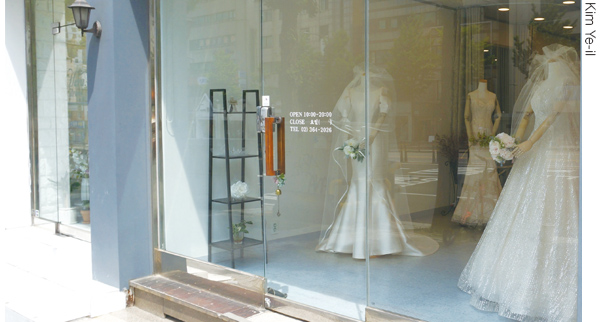
Despite the importance of marriage, the crude marriage rate in South Korea is now declining. The crude marriage rate is the most basic indicator of marriage. It refers to the ratio of the number of marriages during the year to the average population in that year. The value is expressed per 1,000 inhabitants. According to the National Statistics Office (NSO), the crude marriage rate in Korea in 2017 was 5.2 percent, followed by 5.0 percent in 2018. The rate declined further to 4.7, 4.2, and 3.8 in 2019, 2020, and 2021, respectively. Evidently, the decline in the number of marriages is becoming more serious than ever before.
![[Statistics Korea, 2021, “Marriage.Divorce Statistics” (March 17, 2022)]](https://cdn.times.uos.ac.kr/news/photo/202206/10463_10796_84.jpg)

The crude birth rate is no exception. It refers to the ratio of the number of births during the year to the average population in that year; the value is expressed per 1,000 inhabitants. According to the Korean Statistical Information Service (KOSIS) census, the rate was 7.0 in 2017, dropped to 6.4 in 2018. It decreased rapidly to 5.9 in 2019 and 5.3 in 2020. There has been an obvious decrease in the birth rate as well. Maintaining the birth rate in a country is critical because the working-age population is essential to keep the country’s industry running and stabilize the tax revenue. If the younger generation decreases in number, each member of the generation must take the increased burden of senior welfare.
This is a serious problem in Korea as it can lead to an imbalance between generations, and a comprehensive measure is necessary. To cope with the situation, it is necessary to find out why these problems arise. The UOS Times looked back at the history of the thoughts about marriage and the development of the social status of women, which significantly affected people’s views on marriage.
Changes in people’s views on marriage, by period
Traditionally, marriage was an essential and indispensable ritual. Women’s views on marriage were not formed by personal thoughts considering their happiness. They were rather bound and forced by the values and norms of Confucianism that were already in place.
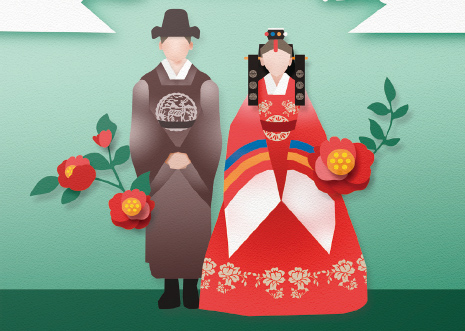
However, as society is changing, people’s views on marriage are also changing. Looking back to the late Joseon Dynasty, Silhak (practical studies, in English) emerged and gave women a new sense of human rights awareness in terms of humanism. Park Ji-won, a Silhak scholar, suggested that women’s essential values and instincts be recognized equally to those of men, and Jeong Yak-yong criticized the Confucian view and suggested a new image of virtuous women. He said a woman who remains with her children without a husband is a truly virtuous person. Such ideas emerged and people began to reflect on various customs that had suppressed women.
In the nineteenth century, as the Joseon Dynasty entered the dissolution period, the Donghak ideology emerged to solve the confusion and crisis occurring in and outside of Joseon, which created a new consciousness for women who had been oppressed under the dominance of Confucianism. Donghak ideology advocated the idea of equality, spreading the idea of equality regardless of gender, social status, and wealth, letting Joseon people encounter a new world of equality. This ideology also stimulated the change and development of women’s consciousness.
In the 1880s, Christianity spread in the Joseon Dynasty, and this ideology stressed new humanitarianism. This became a basis to reduce discrimination and racial prejudice, which eventually led to the change in the perception of equality between men and women. Christianity was based on the liberalism and civic ideology of western countries, and suppressed women needed these thoughts in the Joseon Dynasty; therefore, it was enough to arouse the potential of women. It gave women who were once bound in their homes an opportunity to enter school, go to church, and finally, be active in society. This was an extreme challenge against the patriarchal system.
In the 1920s, the colonial age, a new concept called “new woman” emerged. “new woman” refers to a woman who had received a new education during the Japanese colonial era. New women were the early-generation women who received secondary or higher education and emerged as beings who are seeking new values and attitudes that were not seen before. Women in the 1920s actively expressed their will by pursuing economic independence and raising questions about the existing marriage system. There were also some discussions about free relationships, marriage, and divorce.
The biggest feature of the views on marriage during the Japanese colonial period was the discussion of “love marriage” and “free relationship.” In traditional society, marriage was done to follow the decisions of parents and families regardless of the intentions between the parties. However, later, the concept of love marriage emerged, which is achieved through love between a man and a woman. Then, the free love theory emerged, which suggests that marriage and love can exist separately.
After the liberation from Japanese colonial rule, the overall standard of living improved because of industrialization and modernization. In addition, as individualism, liberalism, and democracy have spread across society due to the influx of Western culture, the structure of individual consciousness also changed. In this process, our society experienced significant social, mental, and material changes. This led to many changes in people’s views on marriage and values.

Students’ views on marriage
The UOS Times conducted a survey to find out UOS students’ views on marriage. The survey included 89 students (46 male and 43 female). The statistical analysis of the results was done at the 95 percent confidence level.
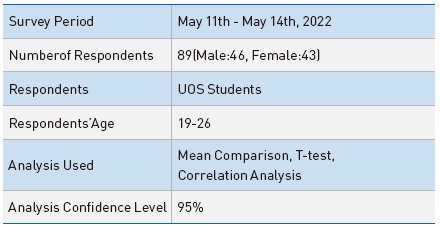
The first question was “Do you wish to get married in the future?” The available options for answers were from 1 (Never) to 5 (Always). The grand mean of the answer to the first question was 3.3, which is slightly above “Neutral.” However, the students’ sex had a significant influence on the answers. The mean of the male students’ answers was 3.5 and that of the female students was approximately 3.1. The t-test confirmed a significant difference between the means of the two groups.
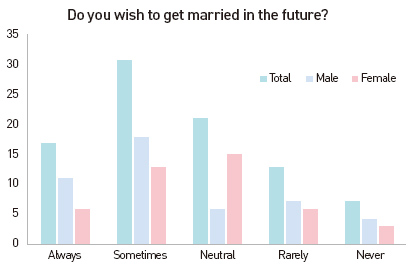
The answers to the question “Do you wish to have children?” showed the largest gap between the sex groups. From a score of 1 (Never) to 5 (Always), the grand mean was 2.85, slightly less than 3 (Neutral). However, the group mean of 3.3 showed that the male respondents were slightly more positive than neutral, while the female respondents’ mean of 2.3 was inclined toward the negative.
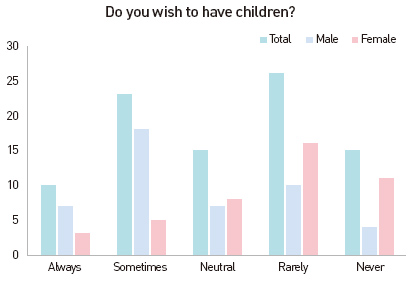
Only eight out of 43 female respondents answered positively to the question, whereas 25 out of 46 males answered that they wanted to have children. The difference was confirmed on the t-test between the two sex groups. In addition, it is interesting that the female responses between the “willingness to get married” and the “willingness to have children” showed a significantly lower correlation (0.54) than that between the male responses (0.76). In other words, female students who wished to get married did not necessarily want to have children.

On the next question, “What is the reason you wish to get married?,” the dominant answer was “To spend the rest of my life with the person I love,” which was selected by 51 respondents (85 percent). This was followed by the answer “To have children,” which had 23 percent (21 respondents) of the total answers.
In terms of the reason not to get married, “Restriction to free life” (61 percent) followed by “Economic burden” (51 percent) were the two dominant answers. In addition, 10 percent of the students selected “Marriage is a career obstacle” as their reason not to get married. Some students said, “I think I can live happily alone without getting married.”
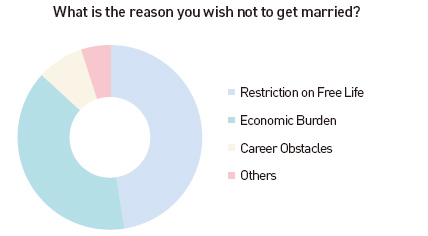
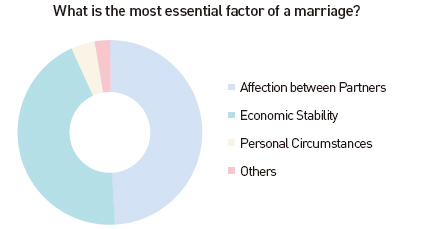
In terms of the most essential factor influencing a marriage decision, 65 percent of the students selected “Affection between the partners.” This result reflects the dominant answer to the second question on the main reason to get married, which was “To spend the rest of my life with the person I love.” 58 percent of the students selected “Economic stability” as the most important aspect of a marriage, followed by “Personal circumstances such as support from family” (30 percent).
The majority of students answered that economic cautions regarding skyrocketing housing prices, overburdening child care expenses, and career instability in Korea caused a poor environment for marriage. Some students said ever-worsening generational conflict, such as “No-kids Zone” issues or civil divisions, was the main reason for difficulties in getting married.
Concerns about economic issues in marriage were reflected in the answer to the question “What is the optimal age for marriage?” The most popular answer was “Between 30 and 34” (73 percent). Considering that most Korean university graduates get employed from their late 20s to early 30s, students thought it best to get married after getting hired and when their finances are stable. Although fewer respondents included “Between 25 and 29” (17 percent) and “Between 35 and 39” (10 percent), none of the respondents said it would be optimal to get married while still below 25 years of age or above 39.

However, most students thought the current socioeconomic circumstance of Korea is not suitable for people to get married. The mean of the answers, scored from 1 (Never) to 5 (Always), was 2.2. Both male and female students agreed that it was difficult to get married in Korea. Although there was a minor difference between the means of the two sex groups (2.08 for male students and 2.3 for female students), the t-test confirmed that the difference was not significant.
To get more detailed thoughts and views on marriage, The UOS Times interviewed two students. Student H is a female student who wishes to get married and Student M is a male student who does not. The following is the interview.
What is the reason you decided to get or not to get married?
Student H: Just as adults miss their childhood, married people reminisce about their single days. Conversely, just like children who want to become adults quickly, I am also one of those who look forward to married life. The first reason is the “mutual complementarity” that I want to achieve with my husband. As a woman, a man with physical features that I do not have is my biggest attraction in terms of complementarity. I hope to live with a spouse who can make up for my shortcomings and whose shortcomings I can make up for with my strengths.
Student M: In Korea, marriage goes beyond the mere fruit of personal love and can be seen as a union between one family and another. Therefore, I decided not to get married because it has a lot of external prerequisites, including not only love-related but also economic ones, and it entails a great deal of responsibility and burden.
How do you view married couples around you?
Student H: I think, in the long term, there is a difference between the married life of a couple that thinks of the wedding only as the final objective of dating and a couple that focuses on planning their life together. Unlike fairy tales, there is no such thing as “happily ever after” in reality.
Student M: I definitely respect people who have accepted the above conditions and got married. However, it does not mean I want to pursue the same path.
What do you think is the main difference between dating and getting married?
Student H: Compared to dating, people have a wider intersection of daily life and life decisions for each other in marital relationships. In particular, I think marriage can serve as a more responsible public safety base in that spouses can act as legal guardians of each other.
Student M: Dating stays at the level of emotional exchange, but marriage concerns the economic requirements and the exchange between families. Marriage is something that goes way further than simple love, with complex intertwined factors.
What do you want your future family to be like?
Student H: Human beings are social beings, and although the form of the family may vary and change, chances are that the “family” itself will never cease to exist. Among the various types of families, for men and women to enter a marriage relationship within the law is the way I want to form a family. Just as a student looking for a “suitable” roommate, I hope to find a suitable spouse and build up richer experiences of growth. “Being identical” means that a large frame of life values overlaps, such as having the same direction in life and having the will to resolve conflicts in a mutually agreeable way.
Student M: While the people who wish to get married supposedly mutually complement each other, I seek to be fulfilled solely by myself. Perhaps I might have a pet as my buddy. I want to live by myself with abundance and relaxation.
As shown from the survey, more than half of students in their 20s answered that they were positive about getting married themselves. However, only one of them replied that the society we live in is suitable for getting married. Thus, it is safe to say that the younger generation is discouraged from getting married irrespective of their will. The assumed economic burdens of married life, including owning a house and child-rearing expenses, are the biggest obstacles to marriage. Apart from financial issues, the female career break after marriage and giving birth was expressed as an issue that needs to be resolved.
Since the beginning of the 21st century, Korea has seen a critical decline in the birth rate. In 2020, Korea became one of the countries with the lowest birth rate. If this trend continues, Korea will not remain the same, according to various demographic studies. Studies show that marriage rate and birth rate have a very high correlation, especially when people get into their first marital relationship earlier. Korea has the lowest rate of births outside marriage in the world. In fact, the survey showed that all UOS students who at least “Sometimes” wished to have children were positive or very positive about getting married. Therefore marriage, so far being the prerequisite of giving birth, is something the society must endorse. Since his election, President Yoon has publicized his future plans to encourage childbirth. The policies included a parental allowance of up to 1 million KRW, an increase of maternal and paternal leave, and extended support for the treatment of infertility. Such policies seem to have reflected the ever-increasing demand from the younger generation for a better environment to have children. The point of focus is the newly launched government, which has now taken up the immense responsibility on marriage and childbirth in Korea. Although no one should be forced to marry, all those who want to do so must be given a chance.
Kim Ye-il
lavieenrose0705@uos.ac.kr
Lee Seung-hyun
nicole3212@uos.ac.kr

